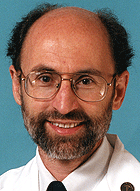A simple points system may soon help guide treatment of elderly heart failure patients, thanks to new School of Medicine research.
The researchers found that by counting how many of seven easy-to-obtain health factors an elderly heart-failure patient has, physicians can estimate the patient’s risk of dying.

The points system may steer doctors toward considering more aggressive treatments such as implantable defibrillators and pacemakers for those at low risk of death. However, elderly patients with a high risk of death may want to avoid stressful and unnecessary medical intervention and could benefit most from palliative or hospice care.
“It has typically been very difficult to predict how long a person hospitalized with heart failure may survive,” said senior author Michael W. Rich, M.D., associate professor of medicine and a geriatric cardiologist at Barnes-Jewish Hospital. “That has made it hard for the treating physician to know how aggressive to be with therapy.”
Heart failure afflicts about 5 million people in the United States, hospitalizing more than 1 million patients each year. The incidence of heart failure increases with age, and with people 65 and older becoming the fastest-growing segment of the population, the personal and financial burden of heart failure likely will increase.
In their study, which followed 282 elderly heart-failure patients for as many as 14 years, the researchers identified seven factors that most affect patient survival:
• advanced age
• a history of dementia (contributes to a host of conditions related to the inability to properly care for oneself)
• coronary artery disease (arteries that supply blood to the heart muscle are hardened and narrowed)
• peripheral vascular disease (similar to coronary artery disease but involving blood vessels outside the heart and brain)
• low sodium in the blood (an indication of neurohormonal imbalance)
• high urea in the blood (a reflection of poor cardiac output that affects kidney function)
• low blood pressure (a result of weakened heart function)
The study, published in a recent issue of the Archives of Internal Medicine, showed that patients with four or more of the risk factors had a low probability of surviving longer than six months. But if patients had none or just one of the factors, they had a good chance of living five years or more. Patients with two to three factors were likely to live at least a year. The patients in the study received a variety of treatments as determined by their physicians.
“The system is easy to use, and the variables don’t require any specialized testing — they are part of routine medical histories or basic lab tests,” Rich said. “If the system can be validated by further studies, it can play a role in helping physicians tailor care to individual patients. If a person has a limited life expectancy, it may not be in his or her best interest to recommend invasive, uncomfortable or risky procedures. On the other hand, an elderly person with only one risk factor could potentially be considered a good candidate for an aggressive treatment such as a defibrillator.”
Other factors that might have been expected to affect survival, such as the amount of blood the heart can eject during pumping or a patient’s body mass index, didn’t seem to influence survival times. Rich emphasized that each of the factors identified has been linked in previous studies to poor prognosis in heart failure patients.
“We didn’t find any new risk factors, which means there’s good data to support that these factors truly are predictive,” Rich said. “We’ve pinpointed the seven that are the most predictive and shown that the number of risk factors can give a reasonable estimate of the probability of living for six, 12 or 60 months.”